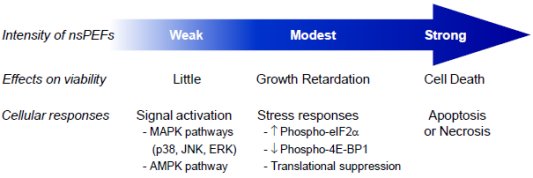Presenter: Ken-ichi Yano (Professor, Inst. Pulsed Power Science, Kumamoto Univ.)
Title: Biological actions and possible medical applications of nanosecond pulsed electric fields
Place: HW525 (Research Building No. 1)
Associated Mission: Mission 5 (Quality of the Future Humanosphere)
ZOOM Meeting ID: 215-314-2974
Abstract
Pulsed electric fields (PEFs) are utilized for a broad range of applications in life sciences, because they have various biological effects depending on the duration and intensity of electric pulses. PEFs in duration of ms to µs are well-suited to electroporation of the cell membrane, and thus, are broadly used to transfer macromolecules into living cells, such as transfection of plasmid DNA. In contrast to the ms-to-µs electrical pulses, nanosecond pulsed electric fields (nsPEFs) do not generate membrane pores useful for macromolecule transfer. Instead, nsPEFs elicit multiple cellular responses that vary depending on the intensity of the applied electric fields (Fig. 1). Relatively mild nsPEFs induce intracellular signaling responses, and sublethal nsPEFs provoke stress responses that involve phosphorylation-mediated intracellular signaling and translational suppression. Exposure to intense nsPEFs results in cell death in vitro and tumor regression in vivo, suggesting the therapeutic potential of intense nsPEFs for cancer. This seminar provides an overview of biological actions and possible medical applications of nsPEFs.
 Fig. 1. Intensity-dependency of cellular responses to nsPEFs
Fig. 1. Intensity-dependency of cellular responses to nsPEFs
nsPEFs elicit distinct cellular responses, depending on their intensities. Relatively weak nsPEFs exhibit little effects on cell growth and cell death but can activate several signal pathways, including various MAPK pathways, like JNK, ERK, and p38 pathways, and AMPK pathway. nsPEFs at modest intensities induce the stress responses that include eIF2alpha phosphorylation, 4E-BP1 dephosphorylation, and translational suppression. Strong nsPEFs cause cell death, and either apoptosis or necrosis is induced in a cell type-dependent manner.
PDF file (120 917 bytes) | Top
30 October, 2019


